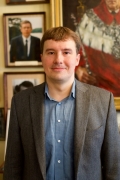The Faculty today
The Faculty of Mathematics and Informatics (MIF) of Vilnius University (VU) delivers teaching and research through four institutes: Data Science and Digital Technologies, Computer Science, Mathematics, and Applied Mathematics. The Faculty offers 9 bachelor’s and 6 master’s courses. Doctoral (PhD) studies are conducted in the areas of informatics, computer engineering, and mathematics.
As of May 2018, the Dean of the Faculty is Associate Professor Paulius Drungilas, a long-time academic at Vilnius University and one of the University’s youngest professors. According to Professor Drungilas, more than 90 % of all students at MIF are state-financed, and are thus the best secondary education graduates of their generation.
Vision
The Faculty of Mathematics and Informatics, one of the largest faculties of Vilnius University, prepares specialists in the areas of mathematics, informatics, statistics and data analysis. The Faculty’s vision is to be an effectively operated and world-renowned centre for informatics, computer engineering, and mathematics studies and research.
Mission
The primary mission of the Faculty is to conduct and develop studies of informatics, computer engineering, and mathematics at all levels, to foster creative and critical-thinking graduates, and to conduct fundamental and applied research and development.
History
The Faculty of Mathematics and Informatics has its roots in the establishment of the Vilnius Academy (University) in 1579, when a Department of Mathematics was established at the Faculty of Philosophy. In its 400 year history, Vilnius University has experienced periods of flourishing, stagnation, revival and closure. The University's rich and controversial history is intertwined with the history of the Lithuanian state, and reflects all stages of its dramatic development.
1579
On 1 April 1579, King of Poland and Grand Duke of Lithuania Stephan Bathory issued a charter establishing the Vilnius Academy, and on 30 October Pope Gregory XIII issued a bull confirming the transformation of Vilnius College into a university. The official name of the university was Academia et Universitas Vilnensis Societatis Jesu (Vilnius Academy and University of the Society of Jesus).
In the University’s opening year, a Department of Mathematics was established at the Faculty of Philosophy.
1795
Under the directions of the Tsarist Russia government, Vilnius University was restructured into four faculties, among them the Faculty of Physics and Mathematics. The Faculty had departments of Pure Higher Mathematics, Physics, Chemistry, Natural sciences, Botany, Agriculture, Astronomy, Applied astronomy, and Civil Architecture.
1832
After the suppression of a Polish-Lithuanian uprising, the University was closed by a decree of Tzar Nicholas I.
1919
After World War I and the fall of the Russian Empire, the governments of emerging Polish and Lithuanian states attempted to reopen Vilnius University. When Vilnius was occupied by Poland, the Polish government reopened the university and named it Stephen Báthory University.
1922
The Lithuanian University was established in the provisional capital Kaunas. The Faculty of Mathematics and Natural Sciences offered courses in mathematics, physics, and other subjects. This faculty always had two departments: Geometry and Mathematical Analysis.
In 1930, the Lithuanian University was renamed to Vytautas Magnus University (Universitas Vitoldi Magni).
1939
With the return of Vilnius to Lithuania, the Polish stage of the University’s development ended. The Lithuanian University returned to Vilnius and was named simply Vilnius University. The Faculty of Mathematics, Natural Sciences, Humanities, and Law was established in 1940.
1940
When Vilnius was returned to Lithuania in 1939, the administration of Kaunas Vytautas Magnus University decided to relocate the faculty of Mathematics and Natural Sciences and the Kaunas Astronomical Observatory, and to merge them with what remained of Stephen Báthory University.
Starting with 1940, the University had a Faculty of Mathematics and Natural Sciences with two departments: Experimental and Theoretical Physics and the Joint Vilnius and Kaunas Astronomical Observatory.
1943
The University was closed again. The Nazi occupation was a great ordeal for the University’s community. Under orders of the occupational government, all Jewish academics were dismissed in 1941. The University continued operating at a limited capacity until it was finally closed in 1943.
1944
Even though the conditions were difficult, the University resumed its activity. Between 1944 and 1965 one of the faculties of the University was the Faculty of Physics and Mathematics. The Faculty had nine departments: Astronomy, General Physics, Semiconductor Physics, Radiophysics, Theoretical Physics, Mathematical Analysis, Geometry and Higher Mathematics, Probability and Number Theory, and Computational Mathematics.
1965
The Faculty of Mathematics and Mechanics was established. It operated until 1978. The Faculty had departments of Mathematical Analysis, Geometry and Higher Mathematics, Probability and Number Theory, and Computational Mathematics.
1971
This year marks the beginning of informatics teaching at the Faculty of Mathematics and Mechanics. At the time, this course was called “Calculation Machines” or “Programming”. The Department of Applied Mathematics and Computing Center were also established in this year.
1978
This year was important for mathematicians, as it marked the separation of different fields of science and the establishment of a Faculty of Mathematics.
1999
The rapid development of IT facilitated the University's modernisation. When the teaching of informatics subjects began, the number of IT courses expanded, and after departments were established, it was decided to change the name of the Faculty. VU Council authorised the renaming of the Faculty of Mathematics into a Faculty of Mathematics and Informatics. The first dean of the Faculty was prof. habil. dr. Feliksas Ivanauskas.
2018
The Faculty of Mathematics an Informatics was merged with the Institute of Mathematics and Informatics; the Faculty now had four institutes: Data Science and Digital Technologies, Computer Science, Mathematics, and Applied Mathematics. The best Lithuanian mathematicians and specialists of informatics and computer engineering work in the institutes.
MIF deans
|
Prof. dr. Paulius Drungilas 2018 - incumbent |
Prof. dr. (HP) Gediminas Stepanauskas 2009 - 2018 |
Prof. habil. dr. Feliksas Ivanauskas 1998 - 2009 |


